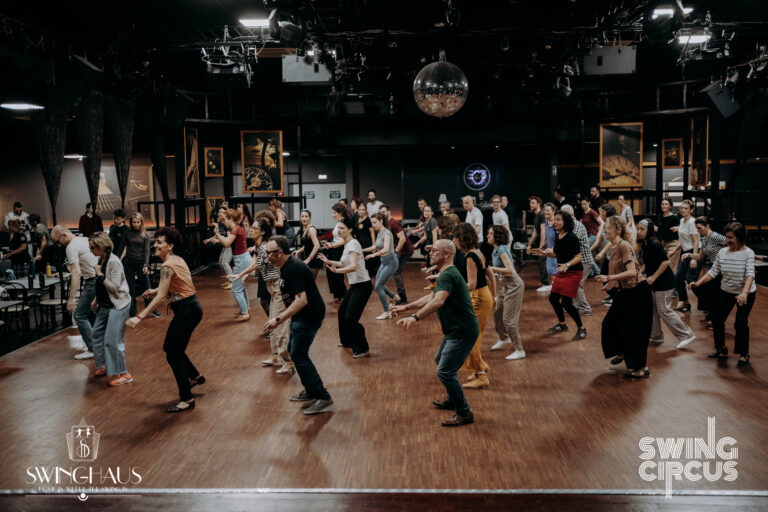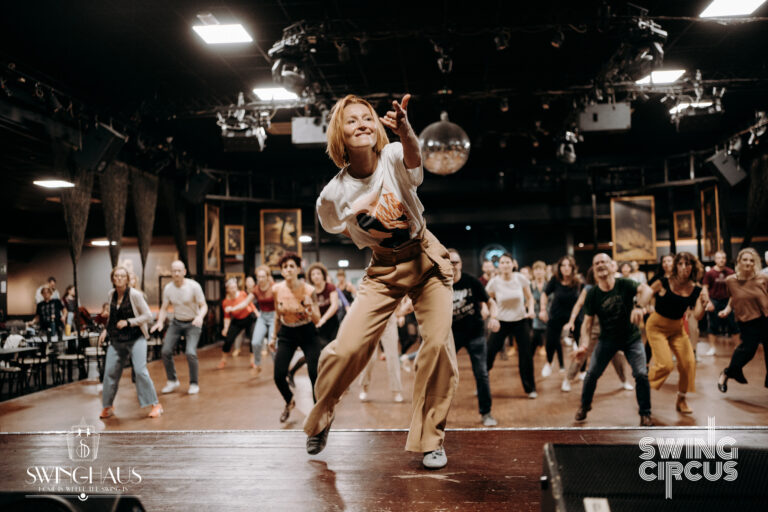The Charleston dance was called “The King of Dances” in the 20th century, leaving a huge mark on American culture.
In this guide, you’ll learn:
- Where the Charleston dance comes from
- How to do the Charleston step in different variations
- The difference between 1920s & 1930s Charleston styles
- Key body technique and aesthetics
- The music best suited for Charleston dancing
- Legendary Charleston dancers to watch for inspiration
Whether you’re a beginner or a dance enthusiast, this article will help you master the look, feel, and rhythm of this iconic jazz-age dance.
Charleston dance history
The name Charleston refers to a city, dance style, step, and song.
Scholars attribute its spread to the Jenkins Orphanage Band from Charleston, South Carolina. The famous Charleston song by James P. Johnson, inspired by Gullah rhythms, became the signature tune for the dance.
Created by African-American communities, the Charleston dance has deep African roots. It was first seen in the streets of Harlem in 1903 and became a national craze in the 1920s thanks to flappers and performers like Josephine Baker in Paris’s Le Revue Nègre.
📖 If you’d like to dive deeper into its origins, read my full article: The History of The Charleston dance.
How to Do the Charleston – 6 Step Variations
Over time, the Charleston “basic” step evolved, reflecting changes in music and culture. Here are six versions of the basic Charleston step:
- Groove Walk – Keep a steady, strong bounce (pulse).
- Kicks – Kick from the knees, keeping the body inclined forward. Move with the kicks rather than staying in one spot.
- Swinging Kicks – A looser, more swinging variation.
- 1920s Twist – Constant light twisting of the feet on every beat, kicking in the air and accenting the offbeat.
- 1920s Glide – Similar to the twist but done without lifting the feet, creating a smooth floor glide.
- Reverse Twist (Afro version) – Keep legs bent low, feet flat, and weight on the heels.
🎥 Learn all 6 versions in this video:
In this video you can learn 6 basic versions of how to do the Charleston “basic” step: groove walk, kicks, swinging kicks, 20’s twist, 20’s glide, and afro version “reverse twist”.
35 Charleston Dance Variations
In a famous 1960s talk show, legendary dancers Al Minns and Leon James demonstrated some of the 35 variations of the Charleston step, including:
Hand-to-Hand
Original 1920s Charleston
Scarecrow
Squat
Around the World
High Kick
🎥 Watch Al Minns & Leon James perform
How to Do the 1920s Charleston Dance Style?
20s Charleston is not only a step, it’s a style. A style that is defined by music, clothing style, manner and expression. 20s Charleston was a craze during the Jazz Age. It is danced to ragtime, hot jazz and Charleston. In order to look authentic we should remember a few important technical elements on how to do the 20s Charleston:
Key Technical Elements:
- Music feel: As it is danced to ragtime and hot jazz (early jazz, Dixieland, New Orleans jazz). The music is syncopated and has a “rag” rhythm though it is still quite even. Accent and bounce on beats 2 & 4.
- Body state: Loose and puppet-like, using joints rather than muscles for light, fast movement.
- Kicks: Accented in the air, not on the floor.
- Feet: Every step has a twist, creating the Charleston’s angular look. Imagine you’re dancing on a hot frying pan!
How to achieve this light yet energetic and powerful state when dancing Charleston 20s? How to handle this hell of a tempo and curvy, twisty moves? We need to adopt the right body state. The imagery for the Charleston body that I love to use is a puppet or marionette. This loose movement, fully working on release, using movement of the joints, so that every kick and move pops to every beat and syncopation in the music.
The magic of Charleston dance is as well in the feet. Every single step is a twist. They create that recognisable angular and asymmetric signature Charleston look. Imagine, you are dancing on a hot frying pan, how would you move your feet?
In this video below you can learn about the Charleston 20s body and the twists!
To dive deeper in the fury of Charleston footwork, try this class on Happy Feet move, one of the signature steps.
20’s Charleston Dance Aesthetics & Influence
There is a lot to learn from seeing the connection of the Charleston dance aesthetics with cultural elements of 20th century America.
- Deep connection to African roots reveals elements of improvisation, spontaneity as well as grounded body position.
- There is connection with flappers and their revolutionary new image of a woman and sexually charged movements.
- Comedy connects to 20s Charleston with its silly moves and irony.
- We can see connection with silent movies through the exaggerated overly dramatic expressions.
- Finally eccentric dance is a part of this dance culture with its legomania and bizarre movements.
You will look super authentic if you will include those qualities, impressions in your dance.
Its important to mention that this dance was immensely popular during the period of 1920’s Prohibition as well as 1930’s Great Depression. When US stock market crashed and part of the society was left in complete poverty, dancing for many was an anti – depression pill. It swept the worries away.
Look at the fantastic Bee Jackson, the “Queen of Charleston” and get ideas on how to do the Charleston! Miss Bee Jackson of the Piccadilly Cabaret and Kit Kat Club demonstrates her gimmick – dancing on a very small floor space.
In this demo video you see me demonstrating the concept of a “Silent Movie”. I am slowing down and speeding up in the real time (without FX), while searching for exaggerated overly dramatic face expressions. The idea comes from the fact that the music was layered on silent movies after the film was done. Oftentimes the music played an atmospheric role. Therefore the dance and movements looked out of time with the actual beat of the song.
Animalism and African roots
I’d like to accentuate the connection with animalism in dance movements as the Charleston dance belongs to the family of African-American vernacular dances. To know more on what are the characteristics of African-American dances that as well reflect in the this dance, read the blog on “ A brief cultural history of black dance”
In this video class from the course Secrets of Charleston 20s, where you can learn how to do the step called the “Cow Tail”. Animalistic move, in a way it was inspired by the cows waving their tail to get rid of the flies.
All of this and more you can learn by taking a course Secrets of Charleston 20s, course with over 40 video.
Iconic Charleston dancers
Some of the iconic dancers to watch, learn and get inspired:
Josephine Baker
Ann Pennington
Bee Jackson
Al Minns
Leon James
Mildred Melrose
Joan Crawford
Jenkins Orphanage Band boys
In this video playlist on Secrets of Solo channel I collected videos of the most famous dancers, historical figures. Watch to get inspired.
Difference Between 1920s & 1930s Charleston Dance Styles
As we mentioned before the Charleston dance style has changed with time and music. I use this categories to spotlight the difference that was strongly affected by the music, more specifically rhythm section.
20s
In 20s Charleston with hot twists and eccentric moves was danced to ragtime, hot jazz music. It has half time pulse and accentuated the 2 and 4 beat. It replicates the bass tuba or the double bass. Bass tuba line for early jazz was either 1 and 3 or 2 and 4. When double bass came to stage, the players wither played half time notes or doubled up on the same note twice. 1/2 feel reflects in half time pulse in the dancers body. The movement is more even, more vertical and ragged.
The 20s style is based on the twists and twisted kick. The most important image is the “crossed” twisted leg. The legend says, some dancers got “Charleston twist” of the knee, when they twisted too hard.
In this video you can hear a very rag song. Notice that the dancers are holding their bodies more upright. Their pulse is ragged (even jumpy at times).
30s
In 1930’s the dance changed with swing music to so called lindy kicks. You could see now dancers doing big wide kicks and travelling across the floor. The feel of the Charleston is 4/4 (4 on the floor). It reflects the double bass in swing tunes, that has a walking line. So called “walking bass”. Musicians say “the bass walks”, when the player hits every single note. 4/4 feel reflects in constant pulse in the dancers body. The movement is “spreading”, it is more horizontal. It looks softer and smoother.
In this video you can hear the 4/4 feel on the bass and clearly see how dancers reflect it in their smooth pulse. Note, when dancers go to lindy Charleston kicks, how much they lower their upper body and start to hover over the ground.
Music to Dance The Charleston
Ragtime
The first tune you would think to dance Charleston to is, of course, famous ragtime tune “The Charleston”, written by James P. Johnson. The Charleston beat is considered a clave rhythm.
As a musical entity ragtime was, and is, an instrumental work in 2/4 time composed for the piano. The style surfaced in the early 1900’s and was developed by composer Scot Joplin. It was the forerunner to jazz. It combines a syncopated series of melodies accompanied by a steady, even rhythm. The left hand plays a steady, almost march-like succession of bass notes and chords while the right hand plays syncopated melodies in a “ragged” manner. Hence, the name of the style.
Here is a Spotify playlist of ragtime tunes. You will hear the music of Eubie Blake, Scot Joplin, James P. Johnson.
Dixieland
Other music style that one can dance 20s Charleston is early jazz. Early jazz, that is as well called “New Orleans jazz”, Dixieland jazz, hot jazz are the terms referring to the same style of jazz based on the music that developed in New Orleans at the start of the 20th century. Its 4 main influences were ragtime, military brass bands, the blues, and gospel music.
New Orleans jazz or Dixieland Jazz was incredibly popular through the 1920s, Jazz Age. One of the first uses of the term “Dixieland” with reference to music was in the name of the Original Dixieland Jass Band (later changed to “Jazz”). They recorded their first vinyl in 1917. What defines the sound of Dixieland music is that one instrument plays the melody (often trumpet) and all the other musicians improvise around it.
Here is a Spotify playlist with a very popular songs for 20s Charleston. You will hear music of such artists as Original Dixieland Band, Fats Waller, Sidney Bechet, King Oliver’s Creole Jazz Band, Frankie Trumbauer and his Orchestra, Fletcher Henderson, Bix Beiderbecke, Jelly Roll Morton, Benny Goodman and other. Or else you can listen to my YouTube Charleston compilation.
Learn the Charleston Dance Online
If you’d like to go beyond reading and actually dance the Charleston, join my course Secrets of Charleston 20s.
It includes over 40 video lessons covering authentic steps, styling, and technique – everything you need to dance like the flappers and jazz legends of the 1920s.




